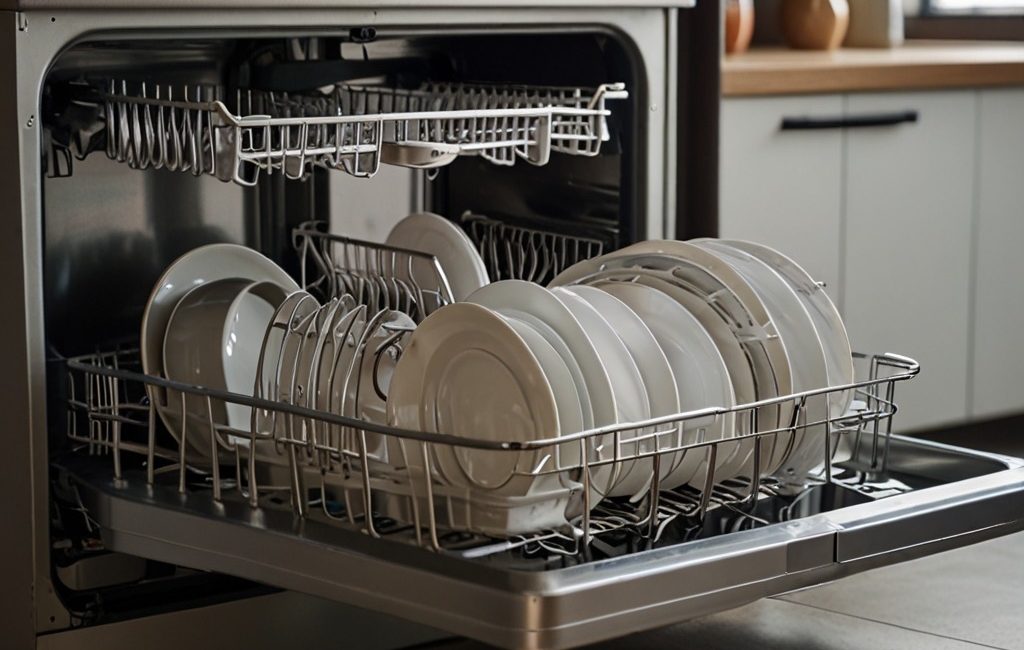A dishwasher is an invaluable appliance in any modern kitchen, saving time and effort while ensuring our dishes come out sparkling clean. However, a common issue many users face is dishes that do not dry properly after a cycle. This can be both frustrating and perplexing, especially when you expect your dishes to be ready for immediate use or storage. Understanding the reasons behind this problem and knowing how to address it can help you get the most out of your dishwasher.
Common Causes for Wet Dishes
- Incorrect Loading:
One of the simplest yet most overlooked causes of wet dishes is incorrect loading. When dishes are stacked too closely together or when larger items block the airflow, it hinders the drying process. Ensure that you load your dishwasher according to the manufacturer’s instructions, allowing adequate space between items.
⠀
- Rinse Aid:
Rinse aid is crucial for effective drying. It helps water sheet off dishes rather than forming droplets that lead to spots and wet surfaces. If you notice your dishes are consistently wet, check your rinse aid levels and refill if necessary. Also, ensure that the rinse aid dispenser is functioning correctly.
⠀
- Dishwasher Settings:
Many modern dishwashers come with various settings, including eco-friendly or energy-saving modes. While these settings are great for conserving energy, they often reduce the drying time or temperature, leading to wetter dishes. Check your settings and consider using a longer drying cycle if available.
⠀
- Heating Element Issues:
The heating element is responsible for raising the temperature inside the dishwasher, which helps in drying the dishes. If the heating element is malfunctioning or broken, it won’t generate the necessary heat to dry the dishes effectively. You can often tell if this is the issue if your dishes are not just wet but also not hot at the end of the cycle.
⠀
- Vent Problems:
Many dishwashers use a venting system to release the hot, steamy air from inside the appliance during the drying cycle. If the vent is clogged or not functioning correctly, the steam will not escape, and your dishes will remain wet. Regularly check and clean the vent to ensure it is not obstructed.
⠀
- Plastic Dishes:
Plastic items don’t retain heat as well as glass or ceramic dishes. As a result, they cool down faster and don’t dry as effectively. While this is a common issue, using a rinse aid and selecting a longer drying cycle can help mitigate it.
⠀
- Hard Water:
Hard water can leave a residue on dishes that makes it harder for them to dry properly. If you live in an area with hard water, consider using a water softener or a dishwasher cleaner designed to tackle mineral deposits.
⠀
Solutions and Maintenance Tips
⠀
- Proper Loading:
Follow the manufacturer’s loading guidelines. Ensure that larger items do not block the flow of hot air and that there is sufficient space between dishes for air circulation.
⠀
- Use Rinse Aid:
Always use rinse aid, and ensure that the dispenser is functioning correctly. Refill the rinse aid regularly and consider adjusting the dispenser setting to increase the amount used during each cycle if necessary.
⠀
- Select Appropriate Settings:
Choose the appropriate drying setting for your load. While energy-saving settings are beneficial, they may not always be suitable if you need your dishes to dry completely.
⠀
- Check the Heating Element:
Regularly inspect the heating element for any signs of damage or malfunction. If you suspect it is not working correctly, consult your dishwasher’s manual for troubleshooting steps or contact a professional for repair.
⠀
- Clean the Vent:
Periodically clean the vent to ensure it is not obstructed by food particles or mineral deposits. This will help maintain proper airflow during the drying cycle.
⠀
- Address Hard Water Issues:
If you have hard water, use a water softener or a dishwasher cleaner to prevent mineral build-up. This will not only improve drying performance but also extend the life of your dishwasher.
⠀
When to Call a Professional?
⠀
If you have tried all these solutions and your dishes still come out wet, it may be time to call in a professional. There could be underlying issues such as a faulty thermostat, a malfunctioning fan, or other mechanical problems that require expert attention.
⠀
At Oceanside Appliance Service Center, we understand the frustration of dealing with a malfunctioning dishwasher. Our experienced technicians are here to help you diagnose and fix any issues, ensuring your dishwasher works efficiently and effectively. Don’t let wet dishes disrupt your routine – contact us today for a professional service that guarantees satisfaction. Call us now to schedule an appointment and enjoy the convenience of perfectly dried dishes every time.
Contact us
